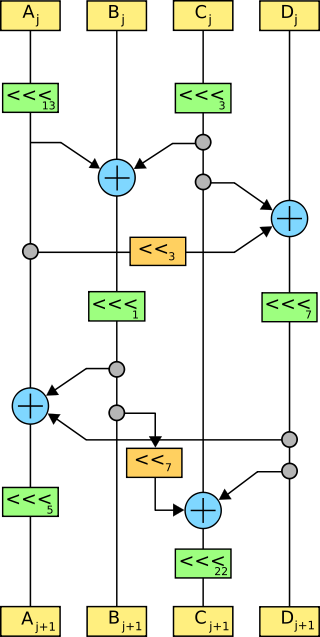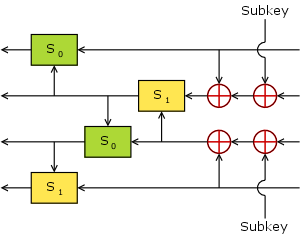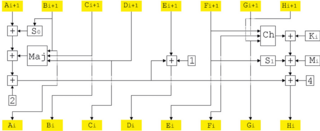
The Data Encryption Standard is a symmetric-key algorithm for the encryption of digital data. Although its short key length of 56 bits makes it too insecure for modern applications, it has been highly influential in the advancement of cryptography.
Differential cryptanalysis is a general form of cryptanalysis applicable primarily to block ciphers, but also to stream ciphers and cryptographic hash functions. In the broadest sense, it is the study of how differences in information input can affect the resultant difference at the output. In the case of a block cipher, it refers to a set of techniques for tracing differences through the network of transformation, discovering where the cipher exhibits non-random behavior, and exploiting such properties to recover the secret key.
A5/1 is a stream cipher used to provide over-the-air communication privacy in the GSM cellular telephone standard. It is one of several implementations of the A5 security protocol. It was initially kept secret, but became public knowledge through leaks and reverse engineering. A number of serious weaknesses in the cipher have been identified.

Eli Biham is an Israeli cryptographer and cryptanalyst, currently a professor at the Technion - Israel Institute of Technology Computer Science department. Starting from October 2008 and till 2013, Biham was the dean of the Technion Computer Science department, after serving for two years as chief of CS graduate school. Biham received his Ph.D. for inventing (publicly) differential cryptanalysis, while working under Adi Shamir. It had, it turned out, been invented at least twice before. A team at IBM discovered it during their work on DES, and was requested/required to keep their discovery secret by the NSA, who evidently knew about it as well.

Serpent is a symmetric key block cipher that was a finalist in the Advanced Encryption Standard (AES) contest, where it was ranked second to Rijndael. Serpent was designed by Ross Anderson, Eli Biham, and Lars Knudsen.

In cryptography, XTEA is a block cipher designed to correct weaknesses in TEA. The cipher's designers were David Wheeler and Roger Needham of the Cambridge Computer Laboratory, and the algorithm was presented in an unpublished technical report in 1997. It is not subject to any patents.

In cryptography, FEAL is a block cipher proposed as an alternative to the Data Encryption Standard (DES), and designed to be much faster in software. The Feistel based algorithm was first published in 1987 by Akihiro Shimizu and Shoji Miyaguchi from NTT. The cipher is susceptible to various forms of cryptanalysis, and has acted as a catalyst in the discovery of differential and linear cryptanalysis.

In cryptography, DES-X is a variant on the DES symmetric-key block cipher intended to increase the complexity of a brute-force attack. The technique used to increase the complexity is called key whitening.
In cryptography, Khufu and Khafre are two block ciphers designed by Ralph Merkle in 1989 while working at Xerox's Palo Alto Research Center. Along with Snefru, a cryptographic hash function, the ciphers were named after the Egyptian Pharaohs Khufu, Khafre and Sneferu.

SHACAL-1 is a 160-bit block cipher based on SHA-1, and supports keys from 128-bit to 512-bit. SHACAL-2 is a 256-bit block cipher based upon the larger hash function SHA-256.
In cryptography, REDOC II and REDOC III are block ciphers designed by Michael Wood (cryptographer) for Cryptech Inc and are optimised for use in software. Both REDOC ciphers are patented.
Introduced by Martin Hellman and Susan K. Langford in 1994, the differential-linear attack is a mix of both linear cryptanalysis and differential cryptanalysis.
In cryptography, impossible differential cryptanalysis is a form of differential cryptanalysis for block ciphers. While ordinary differential cryptanalysis tracks differences that propagate through the cipher with greater than expected probability, impossible differential cryptanalysis exploits differences that are impossible at some intermediate state of the cipher algorithm.
In cryptography, integral cryptanalysis is a cryptanalytic attack that is particularly applicable to block ciphers based on substitution–permutation networks. It was originally designed by Lars Knudsen as a dedicated attack against Square, so it is commonly known as the Square attack. It was also extended to a few other ciphers related to Square: CRYPTON, Rijndael, and SHARK. Stefan Lucks generalized the attack to what he called a saturation attack and used it to attack Twofish, which is not at all similar to Square, having a radically different Feistel network structure. Forms of integral cryptanalysis have since been applied to a variety of ciphers, including Hierocrypt, IDEA, Camellia, Skipjack, MISTY1, MISTY2, SAFER++, KHAZAD, and FOX.
In cryptography, Q is a block cipher invented by Leslie McBride. It was submitted to the NESSIE project, but was not selected.
In cryptography, Ladder-DES is a block cipher designed in 1994 by Terry Ritter. It is a 4-round Feistel cipher with a block size of 128 bits, using DES as the round function. It has no actual key schedule, so the total key size is 4×56=224 bits.
In cryptography, COCONUT98 is a block cipher designed by Serge Vaudenay in 1998. It was one of the first concrete applications of Vaudenay's decorrelation theory, designed to be provably secure against differential cryptanalysis, linear cryptanalysis, and even certain types of undiscovered cryptanalytic attacks.
In cryptography, the Davies attack is a dedicated statistical cryptanalysis method for attacking the Data Encryption Standard (DES). The attack was originally created in 1987 by Donald Davies. In 1994, Eli Biham and Alex Biryukov made significant improvements to the technique. It is a known-plaintext attack based on the non-uniform distribution of the outputs of pairs of adjacent S-boxes. It works by collecting many known plaintext/ciphertext pairs and calculating the empirical distribution of certain characteristics. Bits of the key can be deduced given sufficiently many known plaintexts, leaving the remaining bits to be found through brute force. There are tradeoffs between the number of required plaintexts, the number of key bits found, and the probability of success; the attack can find 24 bits of the key with 252 known plaintexts and 53% success rate.
This article summarizes publicly known attacks against block ciphers and stream ciphers. Note that there are perhaps attacks that are not publicly known, and not all entries may be up to date.

Orr Dunkelman is an Israeli cryptographer and cryptanalyst, currently a professor at the University of Haifa Computer Science department. Dunkelman is a co-director of the Center for Cyber Law & Privacy at the University of Haifa and a co-founder of Privacy Israel, an Israeli NGO for promoting privacy in Israel.
























